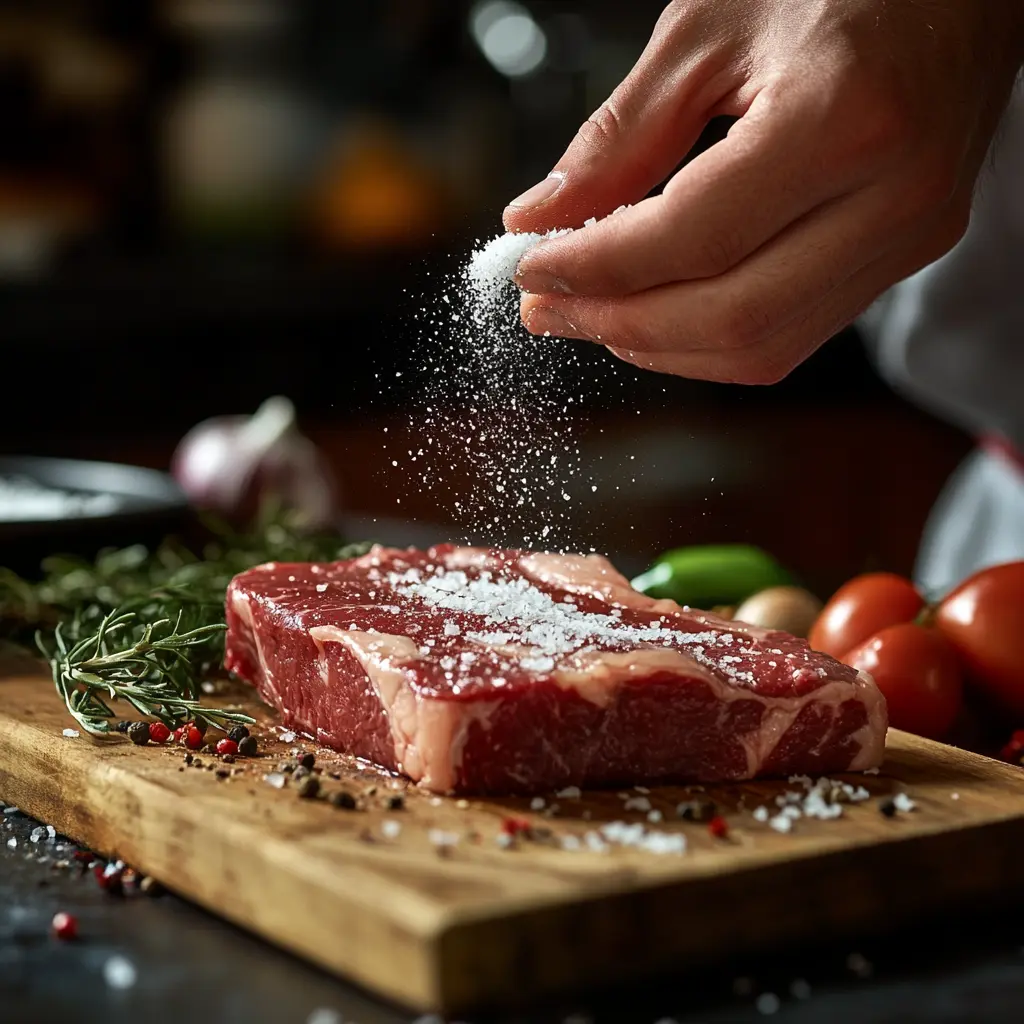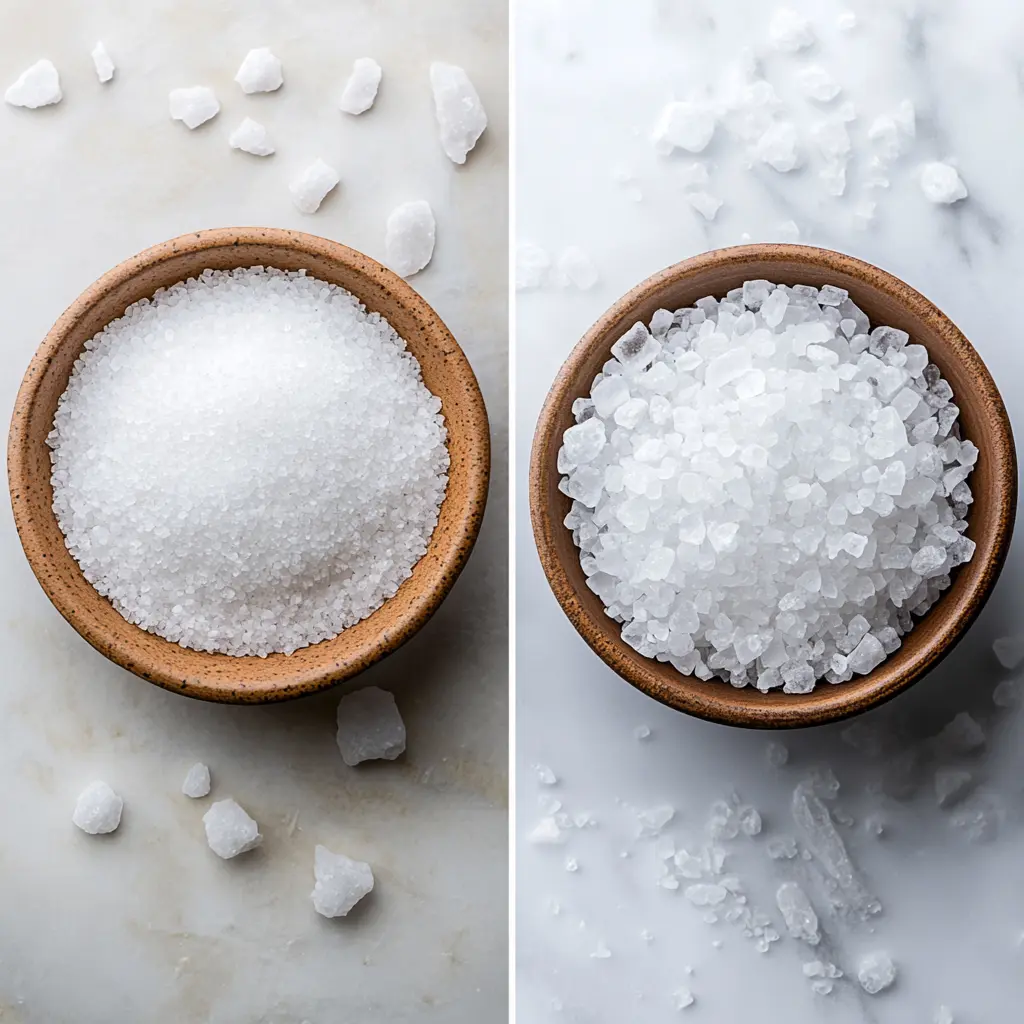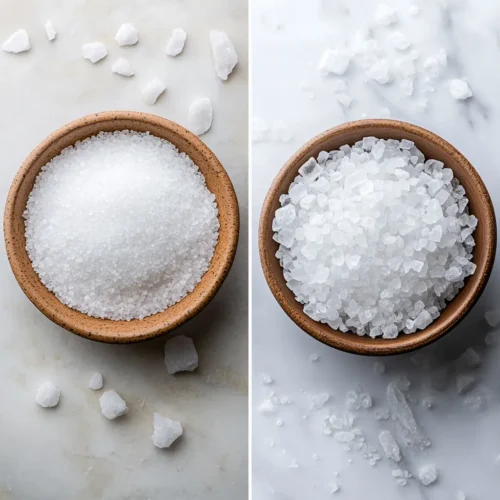Discovering the Difference
A Personal Memory That Changed My Cooking
Cooking has always been more than just combining ingredients—it’s about the small decisions that shape the entire eating experience. I remember one summer afternoon, tossing together a fresh tomato and cucumber salad for friends. My usual kosher salt jar was empty, so I grabbed a container of flaky sea salt. The moment I sprinkled it over the vegetables, I noticed the crystals sparkle under the sunlight. When we took the first bite, the burst of flavor was different—brighter, crunchier, almost celebratory. That simple swap was my first real encounter with the Kosher Salt vs Sea Salt debate.
Since then, I’ve realized that in the world of Kosher Salt vs Sea Salt, salt is never “just salt.” The crystal size, shape, and mineral content all influence flavor delivery and texture. Kosher salt, with its clean taste and easy-to-handle flakes, gives me perfect control when seasoning meats or vegetables. Sea salt, with its delicate crunch, feels like jewelry for food—something to be added at the end to make a dish shine.
Why the Choice of Salt Matters in Cooking
Choosing the right salt isn’t only about taste—it’s also about technique, and this is where the Kosher Salt vs Sea Salt discussion becomes important. Kosher salt dissolves evenly, which is ideal for brining, seasoning pasta water, or layering flavors during cooking. Sea salt adds bursts of texture and a final flourish to finished dishes. In recipes like my Pink Salt Diet Recipe, understanding the role of Kosher Salt vs Sea Salt can completely shift the flavor profile. And in my playful Blue Salt Trick Recipe, the choice between the two affects not just taste but also presentation, which is just as important as seasoning.
Extra Insight: Salt as a Flavor Multiplier
Salt doesn’t just make food salty—it amplifies aromas, balances bitterness, and enhances sweetness. In the Kosher Salt vs Sea Salt conversation, both play unique roles in this flavor enhancement. For example, adding kosher salt to watermelon intensifies its natural sugar, while a sprinkle of sea salt on dark chocolate deepens the cocoa notes. Understanding how Kosher Salt vs Sea Salt impact different flavor elements is why professional chefs treat salt as a tool for layering complexity, not just seasoning.
Table of Contents
Table of Contents
Kosher Salt – The Chef’s Choice
How Kosher Salt is Made and Why It’s Unique
In the Kosher Salt vs Sea Salt debate, kosher salt is unique. Large, coarse crystals form through evaporation and raking, creating flat flakes that cling to food.
It was developed for koshering meat, where its texture draws out moisture without dissolving too fast.
Two main U.S. brands—Morton and Diamond Crystal—differ in density and flake size. Chefs measure by weight to keep seasoning consistent.
When to Use Kosher Salt in Recipes
In the kosher salt vs sea salt conversation, kosher salt is the go-to for cooking. It dissolves steadily, allowing seasoning to penetrate meats and vegetables without clumping. For example, when making my Best Pasta with Seafood, I add kosher salt to the boiling water to infuse flavor into every strand before tossing it with sauce.
It’s also perfect for seasoning large cuts of meat before roasting, mixing into dry rubs, or brining poultry. Its purity—free from anti-caking agents—ensures a clean taste with no metallic after-notes. Once you get used to the pinch-and-sprinkle feel of kosher salt, it’s hard to go back to fine table salt for cooking.

Extra Insight: Measurement Tips for Home Cooks
If a recipe calls for “1 teaspoon salt” without specifying the type, and you use kosher salt, you may need to adjust for brand density. One teaspoon of Morton kosher salt equals about 5 grams, while the same volume of Diamond Crystal equals about 3 grams. This small difference can make a big impact in baking or delicate sauces.
Sea Salt – A Finishing Touch of Flavor
The Origins and Varieties of Sea Salt
Sea salt is harvested from evaporated seawater, a slower and more delicate process than mining. This allows it to retain trace minerals like magnesium and calcium, which can subtly enhance flavor. There’s a world of variety—Maldon from England with its pyramid-shaped crystals, French fleur de sel known for its moisture and delicate crunch, Hawaiian black lava salt infused with charcoal, and pink sea salts with mineral-rich hues.
Sea salt’s flavor differences can be subtle, but its textural and visual appeal is undeniable. Its irregular flakes catch the light and add a gourmet touch to even the simplest foods.

How to Use Sea Salt for Best Results
In kosher salt vs sea salt debates, sea salt wins when it comes to presentation. It’s best used at the very end of cooking, so the crystals keep their crunch. I often sprinkle it over grilled fish, roasted vegetables, or freshly baked bread.
For my Louisiana Gumbo Recipe, I season the base with kosher salt for depth, then finish with a light scatter of sea salt. This last step brightens the flavors and balances the spices without overpowering them. Sea salt also works beautifully on cold dishes like salads or carpaccio, where its texture stays intact.

Extra Insight: Creative Uses for Sea Salt
Beyond savory dishes, sea salt can enhance sweets—think salted caramel sauce, brownies with a sprinkle of Maldon, or chocolate chip cookies topped with flakes. The contrast between sweet and salty wakes up your taste buds and makes flavors linger.
Kosher Salt vs Sea Salt – Side-by-Side
Comparison Table of Kosher Salt and Sea Salt
| Feature | Kosher Salt | Sea Salt |
|---|---|---|
| Crystal Size | Large, coarse flakes | Varies from fine to large, irregular |
| Best Use | Cooking, brining, seasoning meats | Finishing dishes, adding crunch |
| Mineral Content | Pure sodium chloride | Trace minerals |
| Cost | Affordable | More expensive |
Choosing the Right Salt for Every Dish
Use kosher salt early in cooking for consistency, and sea salt at the end for presentation. For more creative pairings, browse my Pinterest board where I share dishes that use both salts strategically.
Common Mistakes When Using Salt
Overlooking Brand Differences
Not all kosher or sea salts are the same—brands vary in crystal size and density, which affects measurements.
Adding Salt Too Early or Too Late
Salt at the wrong stage can either draw out too much moisture or fail to integrate into the dish. Learn to salt in layers, tasting as you go.
FAQ About Kosher Salt vs Sea Salt
Which is better for cooking, kosher salt or sea salt?
Kosher salt is preferred during cooking for its even seasoning and control. Sea salt is better for finishing dishes.
Can you substitute sea salt for kosher salt?
Yes, but adjust measurements—sea salt can be denser, so 1 teaspoon sea salt may be saltier than 1 teaspoon kosher salt.
Is sea salt healthier than kosher salt?
Not significantly. Both are mostly sodium chloride. The trace minerals in sea salt are too minimal to make a major health difference.
Why do chefs prefer kosher salt?
Its coarse flakes make it easy to handle, measure, and distribute evenly, avoiding over-salting.
Conclusion + Pro Tips
In the end, the choice between Kosher Salt vs Sea Salt comes down to your cooking preferences, desired texture, and the type of dish you’re preparing. By knowing the distinct advantages of each, you can season your meals with confidence. Whether you reach for kosher salt for precise seasoning or sea salt for a burst of flavor, remembering the key differences in Kosher Salt vs Sea Salt will elevate your cooking.
Kosher Salt vs Sea Salt Tasting Guide
Ingredients
- 1 tbsp kosher salt (Morton or Diamond Crystal)
- 1 tbsp flaky sea salt (Maldon or similar)
- 1 steak or fresh salad for testing seasoning
- Optional: herbs, spices for flavor layering
Instructions
- Place kosher salt and sea salt in separate bowls for easy access.
- Taste a small pinch of each salt to note texture and flavor differences.
- Season a dish (e.g., steak or salad) using kosher salt during cooking.
- Add sea salt only after cooking as a finishing touch for crunch and presentation.
- Adjust amounts depending on recipe and desired flavor impact.


